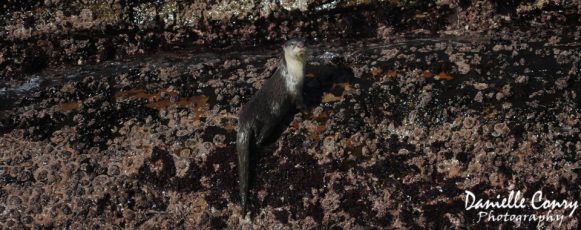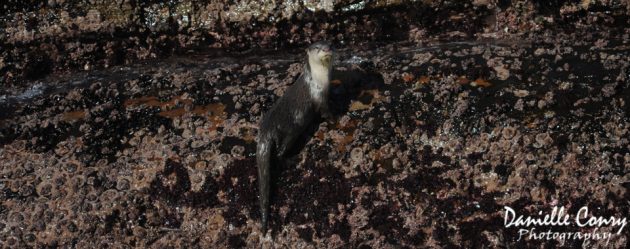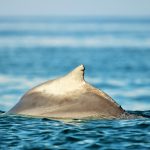Cape Clawless Otter

It is not every day that one gets to glimpse the elusive Cape clawless otter (Aonyx capensis) as it goes about its daily life within many of South Africa’s freshwater systems. These otters belong to the Mustelid family, which includes carnivores such as weasels and badgers. The Cape clawless otter, also known as the African clawless otter, is one of two otter species to occur in South Africa. It is widely-distributed across South Africa and the second largest freshwater otter species in the world, reaching between 113 and 163 cm in length and weighing between 12 and 21 kg. The other species, the spotted-necked otter (Hydrictis maculicollis), is smaller in body size and only occurs around inland water systems in the eastern parts of South Africa.
Cape clawless otters are predominantly aquatic and rely heavily on freshwater systems, as well as thick vegetative cover and an abundant food supply in their environment. They are found in a diverse array of habitats from dams, estuaries and mangroves to arid areas, such as the upper Doring River in the Western Cape, and many seasonal and episodic rivers in the Karoo. These otters also occur in the marine environment, but only in areas in close proximity to fresh water systems, such as coastal rivers or estuaries, and they appear to prefer rocky shores along the coast for foraging. Their reliance on freshwater systems is not only for drinking, but also for rinsing their dense fur of accumulated salt. This restores the thermoregulatory properties of their fur, which is essential as they do not have a layer of subcutaneous fat, or blubber, like many other aquatic mammals to keep them warm in an aquatic environment. In river systems, Cape clawless otters prefer habitats characterised by reed beds, boulders and overhanging vegetation. Such habitats provide prime breeding and shelter sites for crabs and fish, upon which they prey, and as such offer an abundance of food. Cape clawless otters also use vegetation, such as grass and reeds, and sand to help cleanse their fur by rolling around in it.
These otters are predominantly crepuscular, meaning that they are usually only active during dawn and dusk. During this time they will forage for food, which consists primarily of crustaceans such as crabs, but also fish and amphibians. They forage close to coastal shores and river banks and locate their prey by touch using their long whiskers and clawless, unwebbed forefeet. The species often forages on its own, but can be gregarious and is sometimes seen in small groups. During the day these otters remain sheltered in burrows, named holts, which they dig out on vegetated riverbanks, or they rest in dense vegetation. Cape clawless otters occupy home ranges that can vary in size from 4.9 km to 54.1 km and they are generally found at densities of one otter for every 2 km of coast.
Due to the shy nature of Cape clawless otters, they often avoid heavily disturbed urban areas, and when they do occur in urban areas, they are often more nocturnal in order to avoid disturbance from people and dogs. These otters are sometimes observed around Plettenberg Bay, especially in the local rivers and estuaries such as the Keurbooms, Piesang, Salt and Matjies rivers. It was with great surprise and sadness that an adult Cape clawless otter was found dead along the Piesang River recently. It appears that the otter succumbed to a nasty wound, possibly inflicted by a shark. The body of the otter was collected by the local stranding response team and was dissected yesterday to further determine the cause of death.
With expected increases in future coastal and riverbank development, such as the proposed small harbour development in the Piesang River, significant declines in the population numbers of this species may be seen. Local declines are already being reported, with evidence of a 75% decline in Cape clawless otter densities at a river site in the Drakensberg, KwaZulu-Natal. As a result, the species has recently been uplisted to ‘Near Threatened’ on South Africa’s Red Data List. Riverside, wetland and coastal habitats need to be protected to allow otters sufficient breeding and foraging environments in order to ensure their persistence.
Written by Danielle Conry
For further reading:
- Jacques, H., Reed-Smith, J. & Somers, M.J. 2015. Aonyx capensis. The IUCN Red List of Threatened Species 2015: e.T1793A21938767. http://dx.doi.org/10.2305/IUCN.UK.2015-2.RLTS.T1793A21938767.en
- Nel, J. A. J. & Somers, M. J. 2007. Distribution and habitat choice of Cape clawless otters, Aonyx capensis, in South Africa. South African Journal of Wildlife Research 37: 61-70.
- Okes, N., Ponsonby, D. W., Rowe-Rowe, D., Avenant, N.L., & Somers, M.J. 2016. A conservation assessment of Aonyx capensis. In: Child MF, Roxburgh L, Do Linh San E, Raimondo D, Davies-Mostert HT (eds), The Red List of Mammals of South Africa, Swaziland and Lesotho. South African National Biodiversity Institute and Endangered Wildlife Trust, South Africa.
- Parker, D. M., Burchell, R. K. & Bernard, R. T. F. 2005. The diet of Cape clawless otters at two sites along the Bloukrans River, Eastern Cape Province, South Africa. African Zoology 40(2): 330-334.
- Van Niekerk, C. H., Somers, M. J. & Nel, J. A. J. 1998. Freshwater availability and distribution of Cape clawless otter spraints and resting places along the south-west coast of South Africa. South African Journal of Wildlife Research 28(3): 68-72.
- Watson, L. H. & Lang, A. J. 2003. Diet of Cape clawless otters in Groenvlei Lake, South Africa. South African Journal of Wildlife Research 33(2): 135-137.



